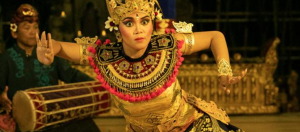The Cudamani Gamelan and Dance of Bali was a performance unlike anything I have ever experienced, and it allowed me to encounter a completely different culture. This performance combined elements of dance with music which allowed the audience to experience multiple mediums of their culture. The start of the performance consisted of a musical number which was played on instruments that I was unfamiliar with, so I was fascinated to listen to these new and unique sounds. After this musical number came the dance performances which were filled with bright colors, costumes, music, and storytelling. Each dance had a theme to it such as nature or water.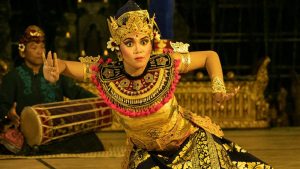
Some of the dances could be seen through the keyword lens of gender because of the feminist approaches they were presenting. A woman who was a member of the group was the one who introduced the dances, and she was also featured in several of the dances as well as contributed to the music. Since it is common that most of these dances in Bali tend to be strictly male, it was progressive that they included women in their performance. I think this exemplified keeping cultural tradition while also evolving to create an environment of inclusivity and equality.
The performers included several aspects to add emotion and drama to the experience. One thing that especially stuck out to me was their facial expressions and how they always kept their eyes so wide. I thought this added drama and a sense of alertness to the dances. I also noticed how throughout the performance the musicians looked so happy and entertained by the music they were playing and the dancing. I personally took this as a sign of their love and pride for their culture. Just by putting on those smiles and embodying a lively persona, it brings life to the performance and a love for their culture.
I am so glad that attending this performance was an assignment for class. Not only did I enjoy learning in a different setting and environment, but it was a way to take in culture in a hands-on setting. I think that this experience embodies a lot of what our Media, Culture, and Identity class is all about. To encompass all these ideas in one thought, this performance was a form of media that embodied the Balinese culture and shared the identity of the Balinese dancers and musicians. We so often read and watch videos about culture and identity but going to this live performance allowed one to be immersed into the culture and experience it first-hand.

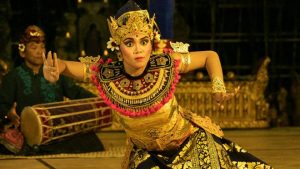
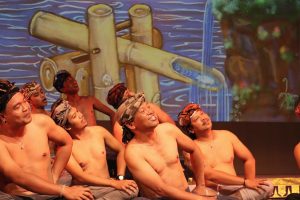
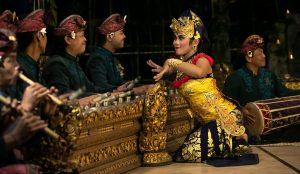
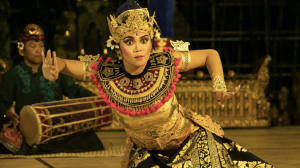
 The Gamelan Çudamani performance combined the music of uniquely crafted Balinese instruments along with the act of dance to tell several stories surrounding various aspects of nature. For me, this was the first time I was able to witness a performance familiar to this—and I’m glad I did! It began with a composition being played by the group. The instruments they used were unlike anything I had seen before. It was then followed up by an introduction to the upcoming acts by a female member of the group. She explained to us that there would be several stories portrayed through dance and the playing of instruments. The stories revolved around topics such as water, animals, and the philosophy of life. Each dance or composition was carefully crafted by members of the group. Some of the dances were choreographed by another female artist. It was later explained that this was a very progressive step in the feminist direction because very rarely had women ever been a main part of the creativity process. Almost immediately after the initial introduction, the members of the Çudamani troop took off with their playing. They consistently changed the volume and rhythm of the music they were creating to help evoke emotion and to give us viewers an idea of how the characters were supposed to be feeling at that time of the performance. For example, one of the stories discussed a disagreement between a group and at one point there was clearly tension amongst the characters present in the scene. The volume increased dramatically and the music became a lot more intense. This aided in creating a sense of tone for the scene. I was immensely impressed by the groups’ ability to have every single note memorized and at their capability to remain in such direct sync with each other.
The Gamelan Çudamani performance combined the music of uniquely crafted Balinese instruments along with the act of dance to tell several stories surrounding various aspects of nature. For me, this was the first time I was able to witness a performance familiar to this—and I’m glad I did! It began with a composition being played by the group. The instruments they used were unlike anything I had seen before. It was then followed up by an introduction to the upcoming acts by a female member of the group. She explained to us that there would be several stories portrayed through dance and the playing of instruments. The stories revolved around topics such as water, animals, and the philosophy of life. Each dance or composition was carefully crafted by members of the group. Some of the dances were choreographed by another female artist. It was later explained that this was a very progressive step in the feminist direction because very rarely had women ever been a main part of the creativity process. Almost immediately after the initial introduction, the members of the Çudamani troop took off with their playing. They consistently changed the volume and rhythm of the music they were creating to help evoke emotion and to give us viewers an idea of how the characters were supposed to be feeling at that time of the performance. For example, one of the stories discussed a disagreement between a group and at one point there was clearly tension amongst the characters present in the scene. The volume increased dramatically and the music became a lot more intense. This aided in creating a sense of tone for the scene. I was immensely impressed by the groups’ ability to have every single note memorized and at their capability to remain in such direct sync with each other.